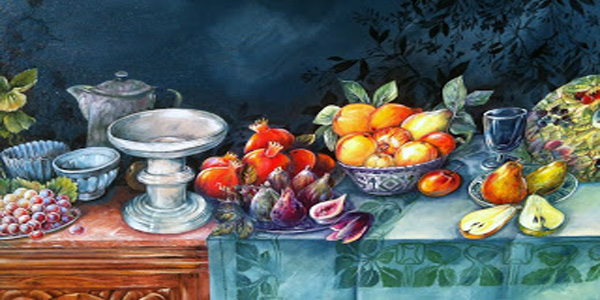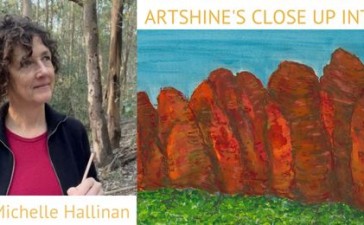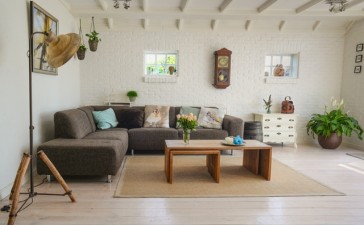Tell us a little about yourself and what you do.
I am trained as a textile designer in some of the best universities in the UK at the time, Winchester and the Royal Collage of Art in London. I look at many people of my age they have done often ten jobs. I have managed to work in textiles, although though changing roles for over 35 years. I work from home for the main part now but it hasn’t always been like this. After leaving collage in 1972 and was head-hunted to go and work in the vibrant Italian market in Milan, for an American designer called Ken Scott, not speaking a word of Italian. I stayed there for three months and started free-lancing which continued for the next 11years in Italy. During this time as well as having London agents who sold globally, I collaborated with many of the great designers. Milan was a vibrant fashion hotspot. With Jacqui Lewis (now Lewis and Lewis) sold designs at the Heimtex trade fair. Along with fashion textiles, I worked with Bassetti a large bed-linen company.
So when Sheridan was looking for a European style designer, my name was put forward and after spending a week in Australia came to work as design director from 1984 till 2001. The initial domestic market dominated by Sheridan expanded to sell in 52 countries. With an amazing boutique on Madison Avenue. I worked with a lot of aussie painters and designs to capture our image to an international audience. I was sent to New York as an advised to Donna Karen starting her bed collection.
After leaving Sheridan, I created a bi-annual book called Colourworks a colour prediction manual that ran for 10 years. I continued designing both textiles for fashion and furnishing. I enjoy teaching, I firstly taught in the Uk organising lecture tours from Glasgow to Winchester, Liverpool and Brighton. I have taught at RMIT (where I have also been external assessor and recently done a master class.) UTS, COFA, Billy Blue and Whitehouse in Sydney.
Although textile design has gone to a large extent overseas, I had some interesting and varied projects last year. Doing a towel range with Prince Albert- UK ceramics range, Working with young designer Gary Bigeni, Doing the centennial scarf for the Queen’s Club and designing an 8 metre frieze for a Pawn shop of the history of the Cross. Today I doing a lot of paintings and have my own greeting card range.
Who (or what) inspires you to do what you love in your own creative business?
I always thought that I wanted to do sculpture as a student in foundation, It wasn’t until I showed by portfolio to my sculpture tutor, who said that I was definitely a 2 dimensional person that I approached textiles. I of course did weave and knit and was drawn to print as my perfect subject. I have always believed that often although you are born with a certain level of talent, that hard work is what makes you shine. I was always drawn to designers before me who had an expression that made them shine. I am lucky that I am able to do lots of different styles and move with fashion, which is essentially about change.
Where do you get your inspiration from when you design/paint?
I love flowers and although I have at some point chosen different techniques, sizes, methods of painting to achieve different canvasses and designs, I am constantly drawn back to the Dutch masters their use of chiaroscuro, their sense of depth within a 2-dimensional plain.
Patient, workaholic, varied, creative and energetic.
Tell us about your very first job and what path have you taken since then?
My first job was working for Ken Scott in Milan. Sat in the rooftops of central Milan, the studio was set in the vicinity of the Duomo. The windows opened onto the most amazing pot garden, larger trees descended in height to smaller flowering beds all in pots. Colour was an essential ingredient of ks’s success. I learnt a lot how butterflies (and nature) were great inspiration to get more original colorations. I learnt for the first time that a bad design in good colours would sell more than a good design in bad colours. Like life, more experience = more adaptability.
Describe a typical day in your studio space?
Perhaps there is not a typical day. My workspace is cluttered and piles of papers /books and materials make it more like a storeroom. The only difference is that view of Rose Bay from my window is stunning. I start work, if I am not going to aqua-aerobics around 7am. Or around 9am. I skip though email to see if there is anything important then get into what I doing. It could be painting/ designing or on the computer. If I am bored at one project I can skip to another, I have always lots of the another project in the wings.
I make time to stop and buy good produce and cook at night. Then continue to do a bit more work before going to bed at midnight. I am a bit of a workaholic.
As an Artist & designer, what is your biggest frustration?
In Australia, sport is considered the big drawcard, design is considered secondary. These days painting is considered a luxury to most people. A lot of customers are discerning what is good or bad and often opt for cheapness rather than aesthetics.
Tell us about how you prioritise your work.
My work is fairly unstructured during the uni holidays. For the main part I can pick and choose what I do when. Deadlines are always important, these I am aware of and structure my work time, tending to do a bit each day so that concepts come together in an orderly way. It is very much like one would prepare a meal so that meat and vegetables have their appropriate cooking times.
Tell us about your teaching & Workshop?
I have always considered that textiles is a craft subject where we learn from older designs what and where to go. We might modify techniques, ways of printing, colour, scale and techniques but the essentials of repeat, flow and feel are always there. I have taught for over 30 years, I try not to have favourites. Try to be fair, patient and balance in the way that I give out criticism . Some students have a natural ability from day one and will always produce exceptional work while others suddenly get in midcourse. Students don’t always put their best foot forward by not reading the brief, not thinking enough about presentation. The best projects are those where all the elements come together in a strong way where graphics, colour, materials and content give out a common message. The most difficult things to teach are having an overview of anything and being blinkered in a narrow vision. One thing I can’t teach to be a good designer is passion, that has to come from the student.
Can you please tell us about how do you connect with other artists, and your customers (i.e. how do you network)?
Knowledge is everything in fashion. Trends often journey along a tightrope formation where one subject introduces another. Descriptive words often are abounded way before movements start. In the past words, like Zen have provoked designers to take their own interpretations of colour, pattern and shape around these words. My advise to you is to get to know designers who are in the know, knowing a few of these will help you shape the future direction. A lot of design starts from the street too,Look.
What advice can you offer other creative people who are just starting out and following their passions?
The first thing that makes a good designer is deciding what is good/ what is bad/ self-criticism. A lot of students especially grab on the first idea that comes into their heads and running with it as the final concept.
Experimentation is essential. Don’t give up at your first attempt and always give your best.
What dreams do you still want to achieve or fulfil in your life?
I love what I do, which in most work fields am a rarity. According to my fortuneteller I will never retire. I hope that I will continue to grow and expand till the end of my days. It is so easy as you get older to refine and refine till you are left will little to refine. It is important to take on new ideas so that you replenishing and renewing to feel that you are growing.
What is your proudest moment so far?
A difficult one. I have been luck to have had more that my 15 minutes of fame. I am often proud at small things like a person will buy a $2 card and come back the next week because she has enjoyed the image so much she wants more. Proud when a poor student excels. Seeing a design of mine being in magazine/ film or being used by the pope on his visit to Australia.
I would like to meet designers that have designed though a long period of time, their process of keeping going, controlling their fame being humble in the process. I would loved to meet David Hockney, I admire his early works, his photography, his theatre sets and his latest work of huge canvasses of the Yorkshire countryside. He still manages to re-invent himself and produce amazing works.
What is the most important lesson in life that you have learned?
That you are replaceable. That there is never enough time. That life goes quicker than you think. That your aesthetic is not always everyone else’s.
That you don’t always have to like what you design for. That the most important lesson in commercial / painting etc is WHO IS MY CUSTOMER
Where do we find you and your products?
For most of the products I design for, I like to see what the competitors are doing and what similar products are available. I would advise designers to build up their own archives as well as relying on the internet to give them solutions, as many fellow designs have the same starting points.
















